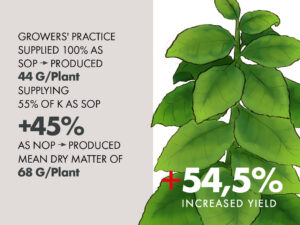Potassium nitrate from natural resources: efficient plant growth
Nitric Nitrogen
Nitrate:
Nitrate is the preferred nitrogen source:
Non-volatile
Unlike ammonium, nitrate is non-volatile and does not require soil incorporation when applied by top or side dressing.
Readily available
Direct uptake by the plant, highest efficiency.
Nitrate promotes the uptake of valuable cations
Whereas ammonium competes for the uptake of K, Ca and Mg.
Nitrate can be readily absorbed by the plant
Urea and ammonium N must first undergo chemichal conversions in the soil before becoming available to plants.
No acidification of the soil
Ammonium must go through nitrification to becom available, a process which increases soil acidity.
Nitrate limits the uptake of chloride
Ammonium can lead to increased chloride uptake.
The conversion of nitrate to amino acids occurs in the leaf
Ammonium has to be converted into organic N compounds in the roots, stealing carbohydrates from processes that promote plant growth and fruit fill.
Potassium
Essential roles of potassium
Potassium promotes photosynthesis, the transport of sugars to fruits and plays an essential role in the production and accumulation of oils.
Potassium sustains season-long leaf function to increase yields and deliver a higher content of soluble solids (more sugars) in fruits at harvest time.
Main Roles:
Promotes the production of proteins
Faster conversion of inorganic N to proteins.
Promotes photosynthesis
More CO2 assimilation, which results in more sugar production.
Intensifies the transport and storage of carbohydrates
More energy flows from leaf to fruit for better yields (Figure 1).

Figure 1.
Improves the efficiency of N fertilizers
Higher nitrogen use efficiency (NUE) leads to higher yields and prevents unwanted N-losses to the environment.
Improves water use efficiency
Regulates the opening and closure of stomata, resulting in less water needed per kg of plant biomass.
Synthesizes lycopene
The synthesis of lycopene creates deep red color in fruit.



